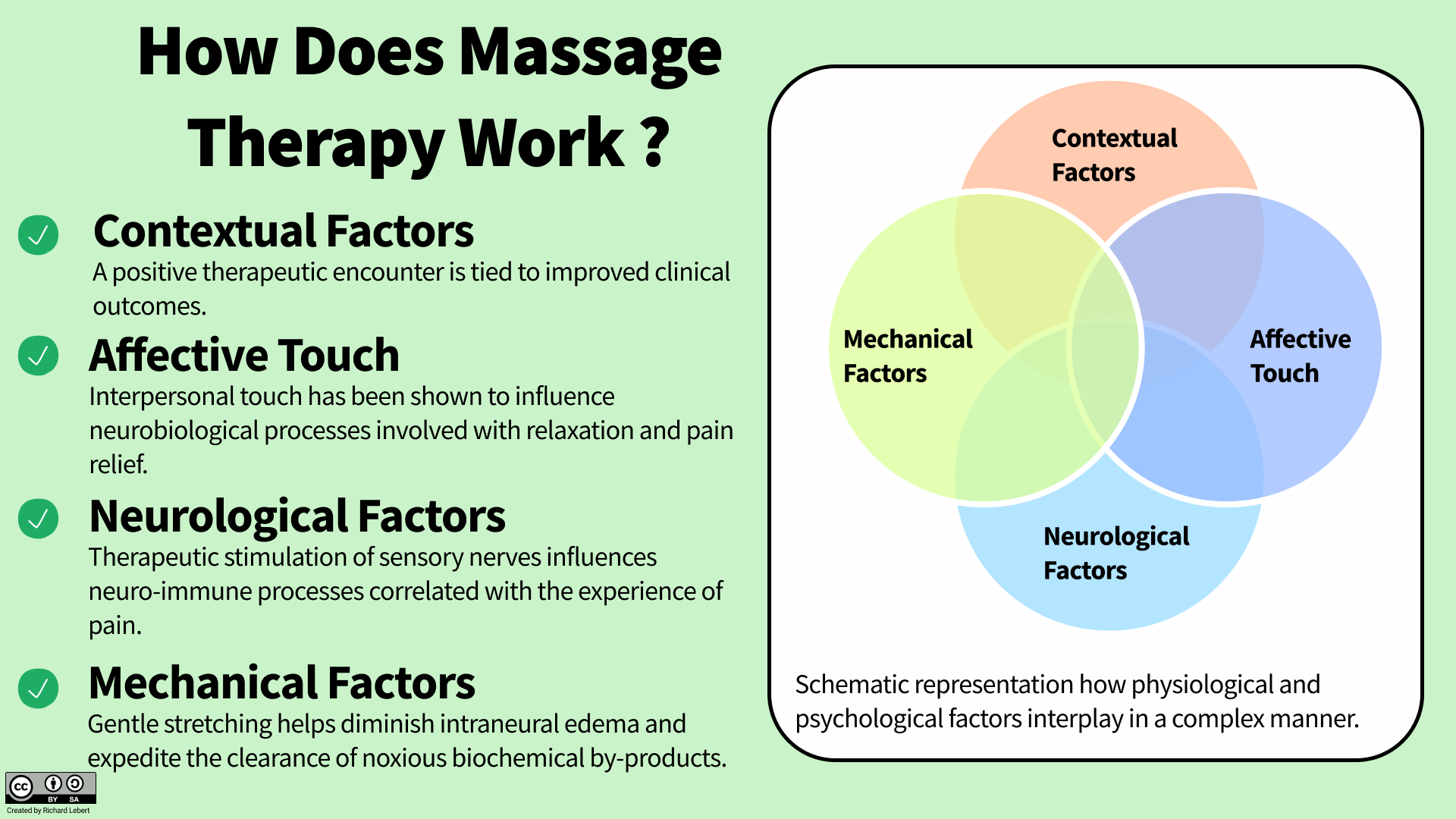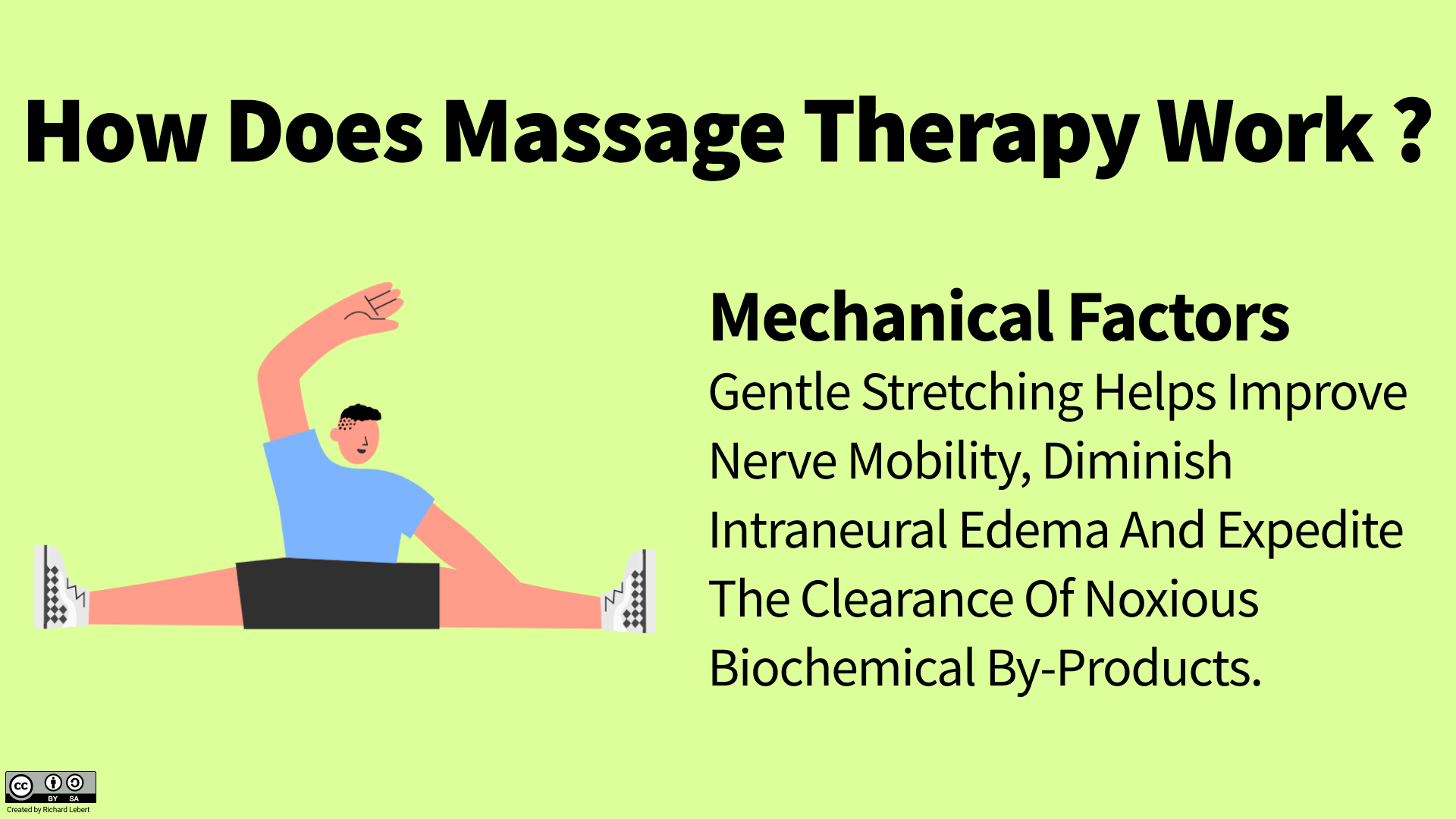How Does Massage Therapy Work ?
/Based on available evidence the best way to describe the effects of massage therapy is as a collection of interconnected responses.
An Evidence-Based Approach to Massage Therapy
Massage therapy is a clinically-oriented healthcare option that can improve quality of life for patients with a variety of conditions. Having an evidence-informed explanation of why massage therapy works can help develop a cohesive message of this conservative approach and the value that massage therapists deliver.
Based on available evidence the best way to describe the effects of massage therapy is not in a single unified response, but as a collection of interconnected responses. A biopsychosocial framework of health and wellness helps put into context the interconnected and multidirectional interaction between biological, and psychosocial factors. More on this below.
Affective Touch: Therapeutic massage is a source of safety, comfort, and relief
Socially appropriate interpersonal touch has been shown to stimulate the release of neurochemicals (endogenous opioids and oxytocin) associated with relaxation and pain relief (Chen et al., 2020; Fotopoulou et al., 2022; Rapaport et al., 2012; Walker et al., 2017). Massage therapy has been shown to influence cortisol levels, but the effect is small and, in most cases, not clinically significant (Moyer et al., 2004; Moyer et al., 2011). In general, a reassuring therapeutic encounter, in which a patient is provided with compassionate touch, provides the patient with a safety message. This can result in reduced physiological and behavioural reactivity to stressors and improved mood/affect.
“We will experience pain when our credible evidence of danger related to our body is greater than our credible evidence of safety related to our body. Equally we won’t have pain when our credible evidence of safety is greater than our credible evidence of danger”- Lorimer Moseley
Contextual Factors: A person-centered clinical experience enhances the natural healing capacity of the body
It has long been known that the way a clinician presents both themselves and their treatment, is tied to health-related outcomes – this is known as the contextual factors of a therapeutic encounter (Rossettini et al., 2018). Creating an environment for healing involves providing a person-centered clinical experience that embraces contextual factors (natural history, regression to the mean, patient-therapist relationship, set and setting) and the natural healing capacity of the body (Ellingsen et al., 2020; Hafliðadóttir et al., 2021; Kaptchuk et al., 2020)
In essence, behaviors and interactions with patients facilitate a relaxation response that will help to influence health-related outcomes; the magnitude of a response is influenced by expectation, learning processes, personality traits, and mindset (Rossettini et al., 2020).
“By definition, CFs (Contextual Factors) are physical, psychological and social elements that characterize the therapeutic encounter with the patient. CFs are actively interpreted by the patient and are capable of eliciting expectations, memories and emotions that in turn can influence the health-related outcome, producing placebo or nocebo effects.” – Rossettini et al., 2018
Mechanical Factors: Therapeutic massage influences tissue and cell physiology
There are several researchers conducting research on the effect of soft-tissue massage on cellular signaling and tissue remodeling; this is referred to as mechanotherapy.
Geoffrey Bove has conducted research examining the effect of modeled manual therapy on repetitive motion disorders and the development of fibrosis. One study published in The Journal of Neurological Sciences showed soft-tissue massage prevented the deposition of collagen and transforming growth factor beta-1 (TGF beta 1) in the nerves and connective tissues of the forearm (Bove et al., 2016). This was followed up by multiple studies showing that by attenuating the inflammatory response (with modeled massage) in the early stages of an injury, they were able to prevent the development of fibrogenic changes in forearm nerves, muscles, and tendons (Barbe et al., 2021; Bove et al., 2019). There is also additional research showing peripheral nerves themselves adapt to appropriate nerve-directed stretching. This improvement in nerve excursion has been shown to correlate with a decrease in pain and disability (Thoomes et al. 2021).
Research demonstrated that massage therapy (effleurage in particular) has a modest effect on local circulation and perfusion both in the massaged limb and in the contralateral limb (Monteiro Rodrigues et al., 2020). Furthermore, a joint research effort between Esther Dupont-Versteegden and Timothy Butterfield of the University of Kentucky and researchers at Colorado State University demonstrated that modeled massage enhanced satellite cell numbers (Miller et al., 2018; Hunt et al., 2019). This was in addition to earlier research from Esther Dupont-Versteegden, Timothy Butterfield and their collaborators at the University of Kentucky, which proposes the idea that mechanical stimulation prompts a phenotype change of pro-inflammatory M1 macrophages into anti-inflammatory M2 macrophages (Waters-Banker et al., 2014). Additional research from Harvard Medical School showed that massage may help flush inflammatory cells (cytokines and chemokines) from injured muscle tissue (Seo et al., 2021).
Taken together this effect on cellular signaling and tissue remodeling (improved nerve mobility, increase in satellite cell numbers and reduction in inflammatory signaling) may improve the body’s ability to respond to subsequent rehabilitation (Van Pelt et al., 2021).
Neurological Factors: Therapeutic massage stimulates specialized sensory receptors
Therapeutic massage is processed by specialized sensory receptors located in cutaneous and subcutaneous structures. Specialized mechanoreceptors located in cutaneous and subcutaneous structures are what informs the body about the type of touch they are receiving, there are five major types of mechanoreceptors that massage therapists should be aware of:
Two of these are located in the superficial layers of the skin: Merkel cells and Meissner corpuscles.
Two receptors, Pacinian corpuscle and Ruffini endings, are found in the subcutaneous and deeper tissue layers.
The fifth type of mechanoreceptor are the recently discovered C-tactile fibers that play a specific role in transmitting the pleasurable properties of touch (they also play a role in affective touch mentioned prior).
Massage therapy is a form of peripheral somatosensory stimulation that can modulate the activity of neuro-immune (peripheral, cortical, subcortical) processes correlated with the experience of pain ( Bialosky et al., 2018; Vigotsky & Bruhns, 2015; Wilson et al., 2021) Through a process of gently stretching muscles, neurovascular structures and investing fascia nociceptive processing associated with tissue damage (actual or perceived) is modifiable in such a way that the pain subsides. Preferential sites for stimulation are associated with areas rich in specialized sensory receptors such as Merkel cells, Meissner corpuscles (superficial layers of the skin), Pacinian corpuscles, Ruffini endings (joint capsules & subcutaneous tissue) and C-tactile fibers which play a role in the singling of affective aspects of human touch.
In Summary
In terms of clinical response to massage therapy, outcomes may be attributed to specific effects (affective touch, mechanical factors, and neurological factors) and non-specific effects (contextual factors). This evidence-informed explanation of why massage therapy works can help develop a cohesive message of this conservative approach and the value that massage therapists deliver.






